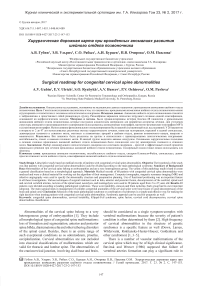Surgical roadmap for congenital cervical spine abnormalities
Автор: Gubin Alexander V., Ulrich Eduard V., Ryabykh Sergei O., Burcev Alexander V., Ochirova Polina V., Pavlova Olga M.
Журнал: Гений ортопедии @geniy-ortopedii
Рубрика: Оригинальные статьи
Статья в выпуске: 2, 2017 года.
Бесплатный доступ
Study Design A descriptive study based on medical records of patients with congenital cervical spine abnormalities. Objective The hypothesis of the study was that patients with congenital cervical spine abnormalities could be divided according to the main pathological syndrome. Summary of Background Data Abnormalities of the cervical spine belong to embryopathies and are a very heterogeneous group. The variety of this pathology made it hard to create a general classification based on a morphological approach. Materials Medical records of 68 patients with congenital cervical spine abnormalities were analyzed and were a clinical material for working out the algorithm of their management. Computer tomography, magnetic resonance imaging (MRI) and selective angiography were used to specify the abnormality structure and preoperative planning. Use of functional positioning was an important feature in all these investigations. Various techniques of surgical treatment such as halo, anterior and posterior fusion, decompression of the cerebral, spinal cord and cervical vertebral arteries, revision of the spinal canal, neurolysis, and meningolysis were used in 28 patients aged from 2 to 47 years old. Results All patients were divided according to leading pathological syndromes. Those were instability, stenosis and brain ischemia. Each group had its own important subgroup. The main surgical steps in management of complex congenital anomalies of the cervical spine were bone fusion or (and) decompression of the brain and spinal cord. Conclusions Selection of the main pathological syndrome or combination of syndromes is a simple and effective way for making the right decision when treating patients with congenital cervical spine abnormalities. Syndromic approach can be used for prognosis as well.
Congenital spine abnormalities, cervical instability, klippel-feil syndrome, spine fusion, cervical cord decompression, cervical spine abnormalities classification
Короткий адрес: https://sciup.org/142121954
IDR: 142121954 | DOI: 10.18019/1028-4427-2017-23-2-147-153
Список литературы Surgical roadmap for congenital cervical spine abnormalities
- Kusumi K., Turnpenny P.D. Formation errors of the vertebral column//J. Bone Joint Surg. Am. 2007. Vol. 89, Suppl. 1. P. 64-71.
- Risk factors in Klippel-Feil syndrome/P.D. Pizzutilo, M. Woods, L. Nicholson, G.D. MacEwen//Spine. 1994. Vol. 19, No 18. P. 2110-2116.
- McLay K., Maran A.G. Deafness and the Klippel-Feil syndrome//J. Laryngol. Otol. 1969. Vol. 83, No 2. P. 175-184.
- Symptomatic atlantoaxial subluxation in persons with Down syndrome/S.M. Pueschel, J.H. Herndon, M.M. Gelch, K.E. Senft, F.H. Scola, M.J. Goldberg//J. Pediatr. Orthop. 1984. Vol. 4, No 6. P. 682-688.
- Sherk H.H., Nicholson J.T. Cervico-oculo-acusticus syndrome. Case report of death caused by injury to abnormal cervical spine//J. Bone Joint Surg. Am. 1972. Vol. 54, No 8. P. 1776-1778.
- Bavinck J.N., Weaver D.D. Subclavian artery supply disruption sequence: hypothesis of a vascular etiology for Poland, Klippel-Feil, and Möbius anomalies//Am. J. Med. Genet. 1986. Vol. 23, No 4. P. 903-918.
- The cervical spine in the Klippel-Feil syndrome. A report of 57 cases/H. Baba, Y. Maezawa, N. Furusawa, Q. Chen, S. Imura, K. Tomita//Int. Orthop. 1995. Vol. 19, No 4. P. 204-208.
- Dyste G.N., Menezes A.H., VanGilder J.C. Symptomatic Chiari malformations. An analysis of presentation, management, and long-term outcome//J. Neurosurg. 1989. Vol. 71, No 2. P. 159-168.
- The natural history of Klippel-Feil syndrome: clinical, roentgenographic, and magnetic resonance imaging findings at adulthood/J.T. Guille, A. Miller, J.R. Bowen, E. Forlin, P.A. Caro//J. Pediatr. Orthop. 1995. Vol. 15, No 5. P. 617-626.
- Scoliosis and congenital anomalies associated with Klippel-Feil syndrome types I-III/N.M. Thomsen, U. Schneider, M. Weber, R. Johannnisson, F.U. Niethard//Spine. 1997. Vol. 22, No 4. P. 396-401.
- Classification of congenitally fused cervical patterns in Klippel-Feil patients: epidemiology and role in the development of cervical Spine-related symptoms/D.D. Samartzis, J. Herman, J.P. Lubicky, F.H. Shen//Spine. 2006. Vol. 31, No 21. P. E798-E804.
- Hensinger R.N., Lang J.E., MacEwen G.D. Klippel-Feil syndrome; a constellation of associated anomalies//J. Bone Joint Surg. Am. 1974. Vol. 56, No 6. P. 1246-1253.
- Hensinger R.N. Congenital anomalies of the cervical spine//Clin. Orthop. Relat. Res. 1991. No 264. P. 16-38.
- 2008 Young Investigator Award: The role of congenitally fused cervical segments upon the space available for the cord and associated symptoms in Klippel-Feil patients/D. Samartzis, P. Kalluri, J. Herman, J.P. Lubicky, F.H. Shen//Spine. 2008. Vol. 33, No 13. P. 1442-1450 DOI: 10.1097/BRS.0b013e3181753ca6
- Occipitalization of the atlas in children. Morphologic classification, associations, and clinical relevance/P.A. Gholve, H.S. Hosalkar, E.T. Ricchetti, A.N. Pollock, J.P. Dormans, D.S. Drummond//J. Bone Joint Surg. Am. 2007. Vol. 89, No 3. P. 571-578.
- Dubousset J. Torticollis in children caused by congenital anomalies of the atlas//J. Bone Joint Surg. Am. 1986. Vol. 68, No 2. P. 178-188.
- The vertebral arteries (segments V1 and V2)/C. Argenon, J.P. Francke, S. Sylla et al.//Anat. Clin. 1980. Vol. 2. P. 29-41.
- Magnetic resonance imaging of C2 segmental type of vertebral artery/K. Sato, T. Watanabe, T. Yoshimoto, M. Kameyama//Surg. Neurol. 1994. Vol. 41, No 1. P. 45-51.
- Anomalous atlantoaxial portions of vertebral and posterior inferior cerebellar arteries/K. Tokuda, K. Miyasaka, H. Abe, S. Abe, H. Takei, S. Sugimoto, M. Tsuru//Neuroradiology. 1985. Vol. 27, No 5. P. 410-413.
- Губин А.В., Ульрих Э.В., Рябых С.О. Перспективы оказания помощи детям младшего и ювенильного возраста с хирургической патологией позвоночника//Гений ортопедии. 2011. № 2. С. 123-127.


